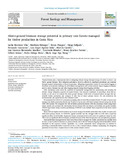Mostrar el registro sencillo del ítem
Above-ground biomass storage potential in primary rain forests managed for timber production in Costa Rica
| dc.contributor.author | Morrison Vila, Leslie | |
| dc.contributor.author | Ménager, Matthieu | |
| dc.contributor.author | Finegan, Bryan | |
| dc.contributor.author | Delgado, Diego | |
| dc.contributor.author | Casanoves, Fernando | |
| dc.contributor.author | Ángel, Luis | |
| dc.contributor.author | Salas, Aguilar | |
| dc.contributor.author | Castillo, Mavin | |
| dc.contributor.author | Hernández Sánchez, Luis Gustavo | |
| dc.contributor.author | y 5 autores más. | |
| dc.date.accessioned | 2021-07-14T03:02:47Z | |
| dc.date.available | 2021-07-14T03:02:47Z | |
| dc.date.issued | 2021-07 | |
| dc.identifier.uri | https://doi.org/10.1016/j.foreco.2021.119462 | |
| dc.identifier.uri | https://repositorio.catie.ac.cr/handle/11554/11056 | |
| dc.description.abstract | Tropical forests play a fundamental role in mitigating climate change through storage of carbon in above- and below- ground biomass. Their mitigation potential is, however, affected by significant greenhouse gas emissions through tropical deforestation or forest degradation. Mitigating degradation caused by conventional logging is therefore an important challenge for silvicultural management, and various reduced impact logging techniques seek to reduce biomass loss and other logging impacts during forest logging activities. Little knowledge exists about the potential of sustainable management for maintaining and restoring the climate change mitigation capacity of tropical forests. Our research contributes to knowledge about this potential, as our aim is to evaluate the above-ground biomass (AGB) stock of tropical forests managed for sustainable timber production and compare it with that of intact primary forests. We also determine the environmental and spatial factors that influence AGB. We estimated the AGB of 141 permanent sampling plots in Costa Rican tropical forests (71 plots set up in areas managed for timber production forests and 70 plots set up in areas with intact primary forests) using data for the 2000–2015 period. We compared the AGB of timber production forests with that of primary forest using linear mixed models and examined the relationship between forest AGB and climate, soil fertility and spatial variables (PCNM eigenvalues) using variation partitioning (VARPART) and multiple linear regression in the mixed model framework... | es_ES |
| dc.language.iso | en | es_ES |
| dc.publisher | Elsevier, Ámsterdam (Países Bajos) | es_ES |
| dc.relation.ispartof | Forest Ecology and Management, Volumen 497 (2021) | es_ES |
| dc.rights | info:eu-repo/semantics/restrictedAccess | es_ES |
| dc.subject | BIOMASA | es_ES |
| dc.subject | BOSQUE TROPICAL | es_ES |
| dc.subject | PRODUCCION DE MADERA | es_ES |
| dc.subject | BOSQUE PRIMARIO | es_ES |
| dc.subject | MANEJO FORESTAL SOSTENIBLE | es_ES |
| dc.subject | MITIGACIÓN DEL CAMBIO CLIMÁTICO | es_ES |
| dc.subject | MUESTREO | es_ES |
| dc.subject | DISTRIBUCION ESPACIAL | es_ES |
| dc.subject | ORDENACION FORESTAL | es_ES |
| dc.subject | COSTA RICA | es_ES |
| dc.title | Above-ground biomass storage potential in primary rain forests managed for timber production in Costa Rica | es_ES |
| dc.type | Artículo | es_ES |


